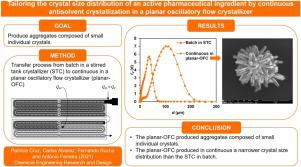Chemical Engineering Research and Design ( IF 3.9 ) Pub Date : 2021-08-27 , DOI: 10.1016/j.cherd.2021.08.030 Patrícia Cruz 1 , Carlos Alvarez 2 , Fernando Rocha 1 , António Ferreira 1

|
An active pharmaceutical ingredient is currently produced in a traditional batch antisolvent crystallization process. Although well-established, this process lacks flexibility to control the crystal size distribution (CSD). Therefore, a new process was developed to enable the control of the CSD according to different specifications. This new process was implemented in continuous in a planar oscillatory flow crystallizer (planar-OFC). In this work, the main goal was to enable the production of small crystals to meet very specific formulation requirements and, simultaneously, promote the aggregation of these small particles to optimize the filtration operation. First, the operating conditions were optimized for continuous operation. Then, the planar-OFC was divided into two spatially independent sections, the nucleation zone (where nucleation is dominant) and the crystal growth zone (where crystal growth is dominant), so as to control the CSD as a function of the residence time in each zone. In particular, the formation of aggregates could be promoted by increasing the residence time in the nucleation zone. Ultimately, the planar-OFC was able to produce smaller particles with significantly narrower CSDs than the traditional batch process. This is particularly important when small particle sizes are required, thus reducing manufacturing time and operating costs.
中文翻译:

通过在平面振荡流结晶器中连续抗溶剂结晶来调整活性药物成分的晶体尺寸分布
目前,一种活性药物成分是通过传统的分批抗溶剂结晶工艺生产的。尽管已经建立,但该过程缺乏控制晶体尺寸分布 (CSD) 的灵活性。因此,开发了一种新工艺以根据不同的规格来控制 CSD。这种新工艺是在平面振荡流动结晶器 (planar-OFC) 中连续实施的。在这项工作中,主要目标是使小晶体的生产能够满足非常特定的配方要求,同时促进这些小颗粒的聚集以优化过滤操作。首先,为连续操作优化了操作条件。然后,平面-OFC 被分成两个空间独立的部分,成核区(其中成核占主导地位)和晶体生长区(其中晶体生长占主导地位),以便将 CSD 控制为每个区中停留时间的函数。特别是,可以通过增加在成核区的停留时间来促进聚集体的形成。最终,与传统的批处理工艺相比,平面-OFC 能够生产出具有明显更窄 CSD 的更小颗粒。当需要小粒径时,这尤其重要,从而减少制造时间和运营成本。与传统的批处理工艺相比,平面-OFC 能够生产更小的颗粒,其 CSD 明显更窄。当需要小粒径时,这尤其重要,从而减少制造时间和运营成本。与传统的批处理工艺相比,平面-OFC 能够生产更小的颗粒,其 CSD 明显更窄。当需要小粒径时,这尤其重要,从而减少制造时间和运营成本。



























 京公网安备 11010802027423号
京公网安备 11010802027423号